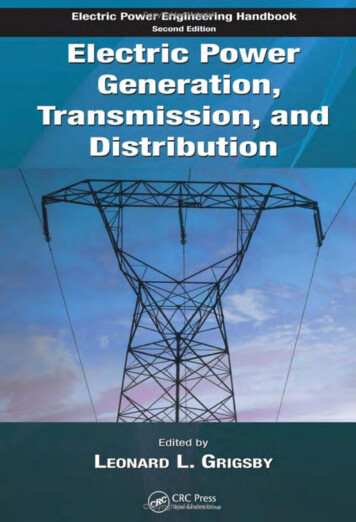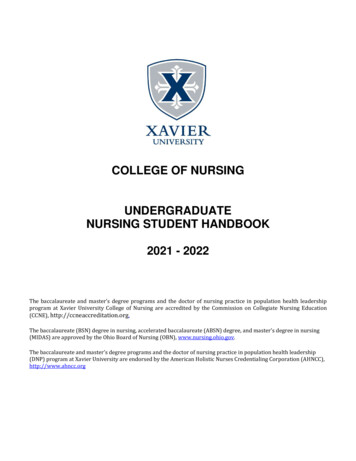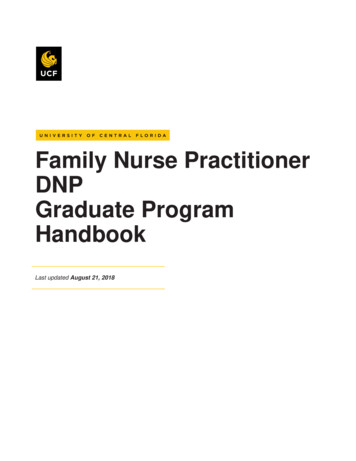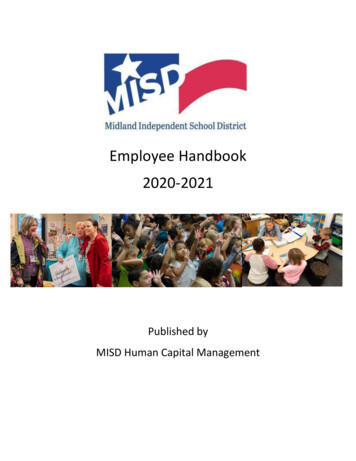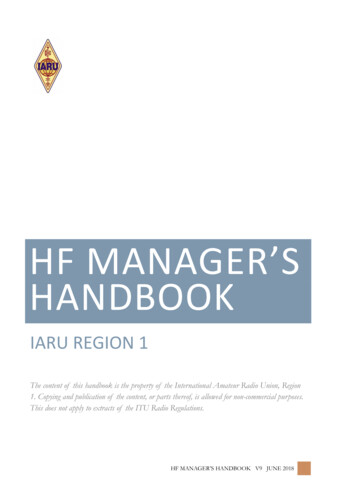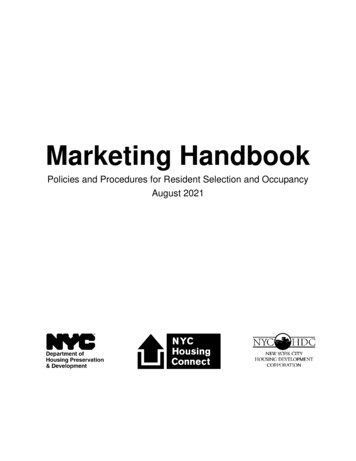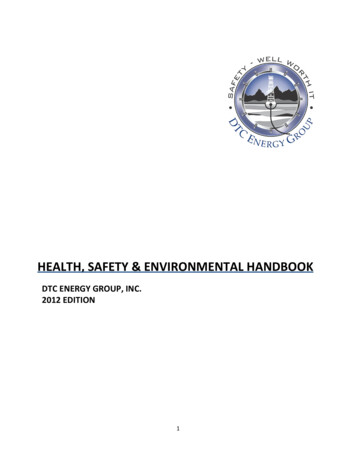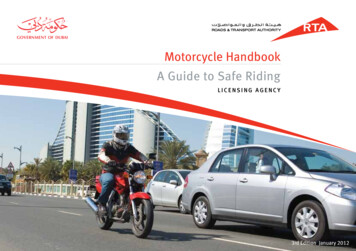
Transcription
About This HandbookThe employee handbook is maintained by University Human Resources and is the officialemployee handbook for all faculty and staff of the University. This handbook is intended toprovide important information on employment policies, practices, procedures, and resources forall employees of The University of Southern Mississippi. However, this handbook is not acontract, and the policies contained herein do not give rise to contractual rights.Because some policies and procedures require periodic updating, the University reserves theright to change, eliminate and supplement the information in this handbook from time to time asdeemed necessary to meet the needs of the University, with or without notice to the employee.Neither this handbook nor any supplements thereto replace, amend, abridge, or anticipatefederal or state law, or the Policies and Bylaws of the Board of Trustees of State Institutions ofHigher Learning. This edition (October 2018) of the Employee Handbook repeals andsupersedes all previous editions; is effective on the date it is published on the University’s website; and, governs all matters and proceedings, whether pending or future.This handbook is not the only document containing personnel-related and other policies of TheUniversity of Southern Mississippi. Approved policies are published on the USM website and inother handbooks and manuals, including, but not limited to, the Faculty Handbook. In addition,college, school, departmental, and divisional policies, procedures, or guidelines may exist andmust be followed by employees as appropriate. The policies and procedures in this handbooktake precedence over any and all other policies that might exist throughout the University, exceptas supplanted by specific provisions of the Faculty Handbook applicable to faculty only.Employment shall be “at will” and shall be terminable “at will” by the University or the staffmember with or without cause. Any oral or written statements or promises to the contrary, otherthan contracts issued by the Board of Trustees of Institutions of Higher Learning, are not bindingupon the University. If you have questions concerning interpretations of the policies containedin this handbook, please contact University Human Resources.DEFINITIONSEmployee: Any individual employed by the University in any status.Staff: Any full-time or part-time benefit-eligible employee that is not a member offaculty.Faculty: The teaching staff and those members of the administrative staff havingacademic rank, as defined in the Faculty Handbook.Non-benefit eligible: Employees of the institution who are in a non-benefit eligiblestatus such as temporary, adjunct faculty, and student workers.
Receipt:As used in this Handbook with respect to the receipt of a notice or other document isdefined as the date that the notice or document is: actually received by the party in question; or,3 calendar days after the notice or document is forwarded to the recipient viaemail and regular US mail, postage prepaid, at the recipient’s last known addressas reflected in the recipient’s official personnel file, whichever is sooner.Summary of ChangesWhen a need for a new policy or a revision to a current policy is identified, University HumanResources’ process is to review the policies with the Employee Handbook Advisory Group(EHAG), whose purpose is to assist HR with employee handbook updates and to providefeedback and suggestions for new policies and policy revisions. The EHAG is composed of staffand faculty representatives from a cross-section of departments and campuses. ExecutiveCabinet is also made aware of policy changes and additions in advance and consulted on anymeaningful changes. Other parties may be consulted as well, depending on the policy, includingStaff Council or Faculty Senate.Minor edits and corrections usually do not go through a review process nor are always capturedin the summary of changes as they are considered non-material changes. For example,information is found to be repetitive, so is deleted out of one section and/or combined in another;the information itself didn’t change, only how and where it was presented.Some changes are driven by legal or regulatory changes in which USM is obligated to comply.These changes do not always go through a review process as they are not optional; however,University HR will communicate those changes as appropriate.Changes effective March 1, 2019:PolicyDescriptionBackground Check policy 2.9:This is a new policy to put our processes into writing. Nonew information or changes to our current processes.Operational Retirement Plan(ORP) policy 4.73:The policy has been revised to provide more information,but no changes.Education Enhancementpolicy 5.9:Revised the policy to state that part-time employees receivea pro-rated award based on hours worked.Grievance Procedure policy 7.2.3: Revised the policy to clarify the process ends at Step 2 forprobationary employment terminations.
Attendance policy 7.6:This is a new staff policy that defines some basicexpectations for attendance and clarifies “jobabandonment” for consistent address across campus.
Table of ContentsChapter 1: Administrative Structure . 91.1 The Board of Trustees of State Institutions of Higher Learning .91.2 The University President .91.3 The University’s Executive Cabinet .91.3.1 Provost and Senior Vice President for Academic Affairs . 91.3.2 Vice President for Finance and Administration . 91.3.3 Vice President for Research . 101.3.4 Vice President for Student Affairs . 101.3.5 Vice President for External Affairs. 101.3.6 Vice President for the Gulf Park Campus . 101.3.7 Director of Athletics . 101.3.8 General Counsel . 101.4 Organizational Charts .10Chapter 2: Hiring Policies . 112.1 Selective Service .112.2 Pre-Employment .112.2.1 Recruitment . 112.2.2 Hiring Process . 122.2.3 Re-Employment . 122.3 Terms and Conditions of Employment .132.3.1 Terms of Employment . 132.3.2 State of Mississippi Employment Conditions . 142.3.3 Briefing a New Employee . 142.3.4 Probationary Period . 142.4 Types of Employment Status .152.4.1 Regular Employee . 152.4.2 Temporary Employee. 152.4.3 Contracts and Grant Employment . 152.4.4 Exempt and Non-Exempt Employees . 162.4.5 Student Workers. 162.4.6 Graduate Assistants . 162.4.7 Work Study . 162.4.8 Adjunct. 162.4.9 Re-Employed Retiree . 172.4.10 Affiliates . 17
2.4.11 Volunteers . 172.5 Employment of Minors .172.6 Employment of Students.182.7 Employment of Foreign Nationals.192.8 Employment Contracts .19Chapter 3: Employment Policies . 233.1 Performance Review and Evaluation.233.2 Outside Employment .233.2.1 Outside Consulting. 243.2.2 Staff Employees Teaching Classes . 243.2.3 Political Participation . 243.3 Changes in Employment Status .253.3.1 Promotions . 253.3.2 Transfers . 253.3.3 Transfers from Other State Agencies . 263.3.4 Interim Assignments . 273.4 Termination Policy and Requirements .273.4.1 Non-Renewal of Contracts for Administrative Staff . 273.4.3 Notice Requirements . 283.4.4 Maximum Leave Allowances . 283.5 Reduction in Force or Reorganization .283.5.1 Procedures for Department/Unit Reorganization. 293.5.2 Procedures for Budget Reductions. 293.5.3 Appeal Process . 303.5.4 Rights of Laid-Off Employees . 313.6 Nepotism .313.7 On-Campus Consulting.323.8 Personnel Records.323.9 Identification Cards.333.10 Drug Testing Policy Commercial Driver’s License .33Chapter 4: Benefits & Services . 364.1 Scholarships for Children for Faculty/Staff.364.2 Faculty/Staff Academic Tuition Waiver.374.2.1 Eligibility . 374.2.2 Procedures . 374.2.3 Courses . 38
4.2.4 Fees . 394.3 Health Insurance .394.3.1 Dependent Coverage . 394.3.2 Administrator . 404.3.3 Open Enrollment . 404.3.4 COBRA . 404.4. Student Health Insurance .404.5 Tax Exempt Benefit Program (Cafeteria Plan).414.6 Workers’ Compensation .414.7 State Retirement System (PERS).424.7.1 Exemptions . 424.7.2 Retirement Eligibility. 424.7.3 Optional Retirement Plan (ORP) . 424.8 Services, Facilities and Privileges .434.8.1 Credit Union. 434.8.2 Payne Center . 444.8.3 Library Services . 444.8.4 Post Office . 444.8.5 Southern Miss Ticket Office . 444.8.6 Audiology and Speech Language Service . 44Chapter 5: Pay Policies . 455.1 Salaried Employees.455.2 Wage Staff .455.3 Deductions .465.4 Standards Workweek and Pay Periods .465.4.1 Standard Workweek . 465.4.2 Rest Periods . 475.4.3 Meal Periods . 475.4.4 Flextime Work Schedule. 475.4.5 Pay Periods. 485.4.6 Paycheck Distribution . 485.5 Overtime .485.5.1 Advance Notice. 495.5.2 Recordkeeping . 495.5.3 Compensatory Time . 505.5.4 Exempt Employees . 505.6 Emergency Callback Pay .505.7 On-Call/Call-back Status and Pay .51
5.8 Holiday Pay.515.8.1 Eligibility . 525.8.2 Religious Holidays . 525.9 Education Enhancement .535.10 Compensation for Grant Employees .53Chapter 6: Leave . 546.1 Scheduling Time-Off .546.2 Personal Leave .546.2.1 Terminal Leave . 556.2.2 Death . 556.2.3 Re-Employment . 556.3 Major Medical Leave .566.3.1 Terminal Leave . 576.4 Family and Medical Leave Act.576.4.1 Eligibility . 586.4.2 Qualifying Reasons . 596.4.3 Leave Period . 606.4.4 Call In and Time Off Procedures . 606.4.5 Proper Notice by Employer . 616.4.6 Certification . 616.4.7 Approval of Leave . 626.4.8 Military Caregiver Leave . 626.5 Leave of Absence without Pay .636.5.1 Reinstatement . 646.5.2 Employee Benefits . 646.6 Military Leave.646.7 Compulsory Leave .656.8 University Declared Leave .656.9 Leave Balances and Accruals .656.10 Jury Duty.666.11 Voting .666.12 Leave for Grant Employees .66Chapter 7: Workplace Expectations and Disciplinary Guidelines . 687.1 Progressive Discipline .687.1.1 Purpose. 687.1.2 Policy . 68
7.1.3 Procedure . 687.1.4 Example Rule Violations . 727.2 Grievance Procedure .727.2.1 Definition . 727.2.2 General Procedures . 737.2.3 Specific Procedures . 747.2.4 Grievance Panel . 757.3 Sexual Misconduct .787.4 Equal Employment Opportunity .787.5 Disabilities and Reasonable Accommodations.797.5.1 Definitions. 807.5.2 Procedure for Reasonable Accommodation. 817.5.3 Steps for Requesting a Reasonable Accommodation . 82Chapter 8: Other University Information . 858.1 University Committees .858.2 Retiree Privileges .858.3 Pertinent University Policies .88
Chapter 1: Administrative Structure1.1 The Board of Trustees of State Institutions of Higher LearningThe University of Southern Mississippi is one of eight institutions operating under the authorityof the Mississippi Board of Trustees of State Institutions of Higher Learning (IHL). Created in1944, the purpose of the Board is to manage the institutions of higher learning in accordancewith the state constitution and to ensure the IHL system’s mission is accomplished. The Boardconsists of 12 members appointed by the Governor and approved by the Senate for nine-yearterms. Membership includes four representatives from each of Mississippi’s three state SupremeCourt districts. Administrative offices of the Board are located in Jackson, Mississippi.1.2 The University PresidentAppointed by the IHL Board of Trustees, the President of The University of SouthernMississippi is charged with serving as the chief executive officer and principal educationalofficer of the University. As designated by IHL, the President is responsible for every facet ofinstitutional operations, to include shaping the University’s educational policy and academicstandards; holding final authority over all employees; maintaining appropriate standards ofstudent conduct; and managing the University’s financial resources in accordance with IHLpolicy.1.3 The University’s Executive CabinetThe University of Southern Mississippi’s Executive Cabinet serves in an advisory capacity to theUniversity President on matters related to institutional decision making, including policydevelopment and implementation; budget development and implementation; human resourcesmatters; oversight and governance by IHL; compliance with state and federal laws andguidelines; the welfare and wellbeing of the institution’s faculty, staff and students; the role ofthe University in the local, state and regional communities; support of the University by friendsand alumni; research production; and economic development. Membership consists of eightexecutive officers as listed below and one representative each from the faculty, staff and studentbodies.1.3.1 Provost and Senior Vice President for Academic AffairsThe Provost and Senior Vice President for Academic Affairs is the chief academic officer andsenior University officer next to the President. The Provost oversees all matters pertaining toacademic programs, curriculum development, faculty affairs, student affairs, other educationalobjectives of the University and related financial resource management.1.3.2 Vice President for Finance and AdministrationThe Vice President for Finance and Administration is the chief financial officer and oversees theUniversity’s financial operations, facilities planning and management, human resources,procurement and contracted services, information technology, and parking and transit services.All EmployeesStaffFacultyNon-benefit eligible
1.3.3 Vice President for ResearchThe Vice President for Research serves as the chief research officer and oversees theUniversity’s research enterprise and related economic development and outreach functions. TheVice President for Research is also the executive director of the USM Research Foundation.1.3.4 Vice President for Student AffairsThe Vice President for Student Affairs oversees a wide range of programs and services thatenhance the quality of life for the University’s diverse student body. The Vice President forStudent Affairs also manages student conduct matters and student crisis support and response.1.3.5 Vice President for External AffairsThe Vice President for External Affairs oversees government relations as well as alumni anddonor development and engagement.1.3.6 Vice President for the Gulf Park CampusThe Vice President for the Gulf Park Campus oversees operations at the University’s Gulf Parkcampus located in Long Beach, Mississippi.1.3.7 Director of AthleticsThe Director of Athletics oversees the University’s competitive intercollegiate athletics programand ensures that all athletic programs and initiatives align with the institution’s educationalmission and goals.1.3.8 General CounselThe General Counsel provides legal representation to the University when necessary and advisesthe University’s executive officers, faculty and staff who are acting on behalf of the institutionon various issues that are in the best interest of the University.1.4 Organizational ChartsOrganizational charts are available through the Office of Institutional Research.All EmployeesStaffFacultyNon-benefit eligible
Chapter 2: Hiring Policies2.1 Selective ServiceWith an exception of few, all male U.S. citizens and male immigrants residing in the U.S.between the ages of eighteen (18) and twenty-five (25), are required to register under the federalMilitary Selective Service Act, and if seeking employment, or if seeking a promotion to a higherposition with the University, shall submit to the University satisfactory documentation of hiscompliance with the draft registration requirements of the Military Selective Service Act.2.2 Pre-Employment2.2.1 RecruitmentThe University is committed to the recruitment and retention of a diverse and skilled workforce.Recruiting the best candidate for the position vacancy is accomplished by:1. Posting: All full-time and part-time vacancies, including temporary positions, arerequired to be posted through the online applicant tracking system. Postings may belimited to internal or department-only, per management discretion; however, a posting,screening and selection process must still occur. Faculty positions are also required to beposted utilizing the online applicant tracking system. Student worker positions aremanaged and posted by Career Services.2. A job enlargement is when the scope of a job is increased through the addition of jobduties and responsibilities. Job enlargements are not required to be posted, even whenresulting in a promotion or pay raise, so long as the position is essentially the same, theformer position is not being back-filled, and there is no more than 1 incumbent in theposition. University Human Resources should approve all job enlargements in advance.3. All positions must be posted for a minimum period of five (5) working days. If a holidayfalls within the posting period, it will not be considered in the minimum required period.If a position becomes vacant that has been posted in the last 120-days, a new posting isnot required and the hiring manager may select from the applicant pool of the previousposting. For UPD, a new posting is not required for a 1 year period. A department headmay extend a posting past the minimum period by stating such on the position requisitionat the time of posting. Positions may also be posted “until filled” utilizing the guidelinesin the Hiring Toolkit. The AVP of Human Resources is authorized to waive or shortenthe posting period requirement in extenuating ci
About This Handbook The employee handbook is maintained by University Human Resources and is the official employee handbook for all faculty and staff of the University. This handbook is intended to provide important information on employment policies, practices, procedures, and resources for all employees of The University of Southern Mississippi.

